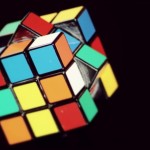This will be the first post in a periodic series resolving paradoxes.
The paradox of Buridan’s ass is amusing and has many variations. It was originally formulated by Aristotle (or perhaps even earlier) but popularized by the French philosopher Jean Buridan. It’s considered a paradox even though no logical contradiction is involved – just an odd conclusion. Imagine the following:
A hungry donkey stands between two identical hay piles. The donkey always chooses whichever hay is closest to him. Both piles are exactly the same distance apart, one on his right, one on his left, and they are identical in every way. Which pile of hay will the donkey choose to eat?
According to the paradox, because they are equidistant apart, he will be unable to choose and will starve to death in his paralysis. It might sound like a silly thought experiment, but it actually brings up some interesting points, and in this particular case, a useful clarification.
Let’s substitute a human for a donkey. And for the sake of argument, imagine that hard determinism is true – the belief that human beings have no free will and are ultimately complex machines. This implies that all behavior, including any “choices” that humans make, is ultimately the result of cold, mechanical computation by the brain.
What would happen if this brain evaluated two potential actions identically? Imagine the brain were presented with a simple choice: it could open a door on the left or a door on the right. If it calculated each option exactly the same, would it be unable to act? Remember, there’s no room for capriciousness or a human “will” in this scenario.
The conundrum also applies to ethics. Take the following premise: “Given possible alternatives, man should always choose the greater good.” So what happens when two alternatives are judged equally good? Buridan himself concluded that no rational choice could be made and that we should suspend action or judgment until circumstances change.
All of these examples resolve themselves upon carefully examining our language. If we aren’t careful, Buridan’s ass begins with very common framing mistake, which I see entailing a logical contradiction. The culprit is an incorrect use of the word “identical” – a conflation of “identical in all ways” with “identical in most ways”.
Quite simply: there’s no such thing as “identical options”. More specifically, there are no two separate things which are identical in every way. So when talking about choice, having “alternative” possibilities implies having “different” possibilities. We can not evaluate two things as both “identical and different”, as this would be a contradiction in terms. Therefore, any formulation of Buridan’s paradox which implies this contradiction runs into a basic framing error.
Take the following example: let’s say I want to wear a t-shirt, so I purchase a two-pack from the store. I open the package and lay them out before me. In our daily language, we might say both shirts are “identical”, but this is inaccurate. Granted, it’s how we commonly use the term, but it is not precise. Two shirts laid side-by-side might be the same color, the same brand, the same smell, but they are two completely different things. One shirt is “on the left”, and the other is “on the right” – immediately we can recognize their difference in terms of spatial location. Two exactly identical things must be identical in all respects – including their location.
If the two shirts have different locations, then we’re presented with no difficulty in choosing one. Though we may not consciously think we prefer “shirts on the left” to “shirts on the right”, our actions demonstrate a sub-conscious preference at the very least.
So let’s revisit the earlier examples keeping this in mind: if it’s possible to differentiate between things, those things must not be identical.
Take our donkey: from the beginning, we’re presented with a problem: the donkey is supposedly between two identical bales of hay. Immediately, we can identify this as impossible. Bale X is located in position A, while bale Y is located in position B. Two perfectly identical things must occupy the same space at the same time.
But all is not lost; we can paralyze the donkey by creating stricter premises: the donkey makes his decisions only based on relative distances from the hay; he only chooses hay which is closest to him, and the hay is exactly equidistant from the donkey. In that circumstance, it must logically follow that the donkey could choose neither bale of hay – not because the hay bales are actually identical, but because the donkey is unable to act on the difference between the two, based on our strict premises.
The same applies to a determined brain. If the only factor governing action were a mathematical evaluation, then two possible outcomes with the exact same evaluation would result in inaction. We could even say that “choice” only happens with an unequal evaluation of possible outcomes. And to the extent that such a brain does act, we can conclude its evaluations of possible alternatives were unequal.
Finally, the same conclusion is reached in regards to ethics. If we must only act based on the greater good, then any situations without a greater good (when two possible outcomes are tied) must result in inaction. Simple.
All of these conclusions follow from our strict formulation of premises. In the real world, it’s safe to say the premises are never true – we never act based solely on moral evaluation, and of course, we’d never find such a donkey perfectly equidistant between two bales of hay. Regardless of the implausibility of the premises, I think this example helps us think clearer, and more importantly, it clears up any framing errors: in no circumstance can two perfectly identical things be differentiated.


